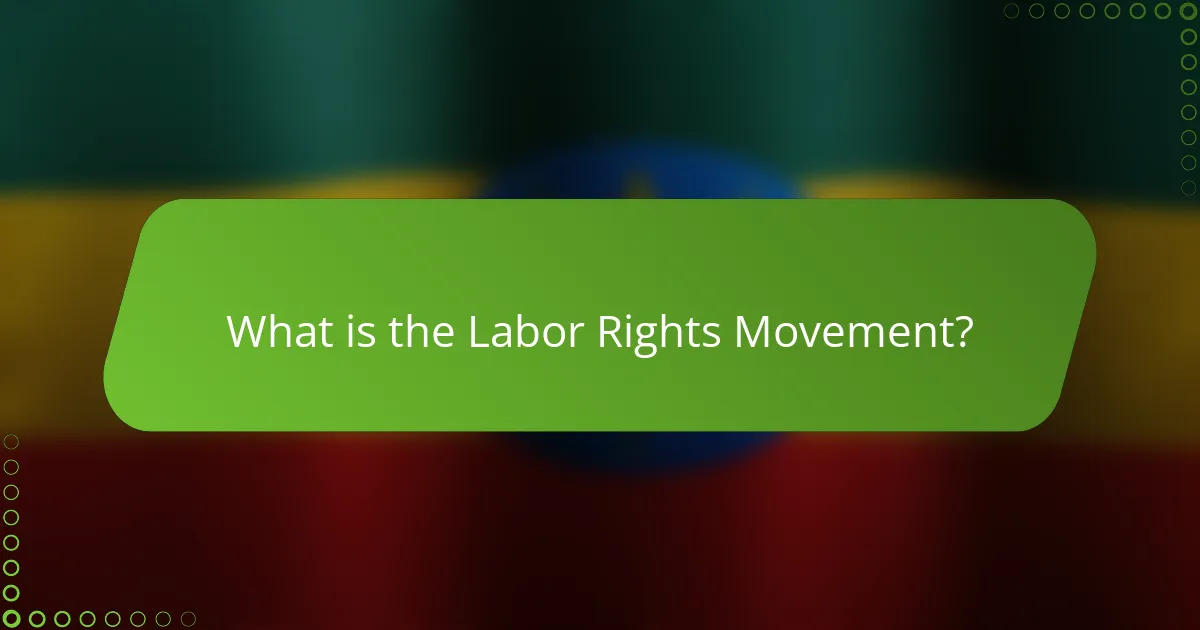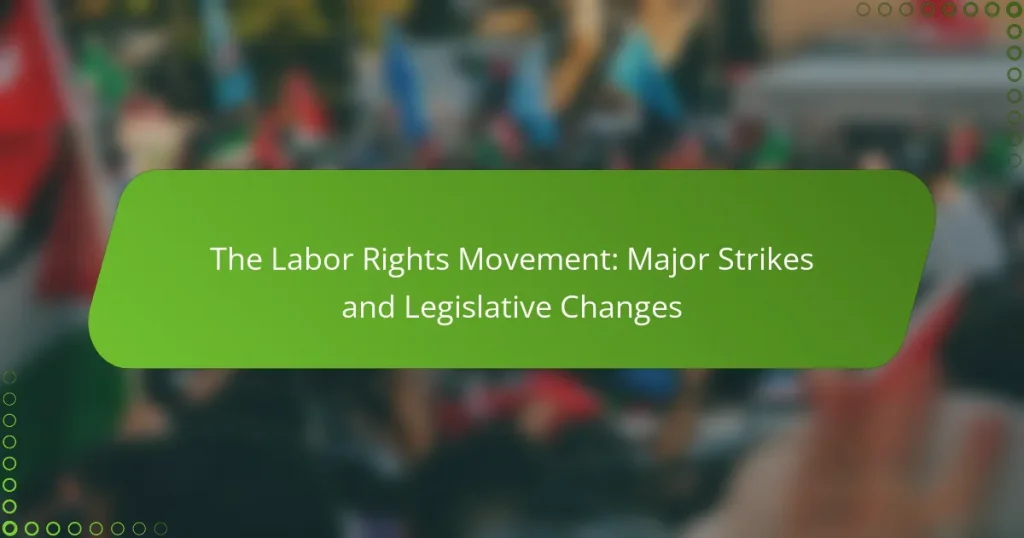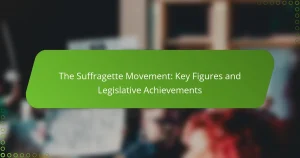The Labor Rights Movement is a significant social and political effort aimed at advocating for the rights and protections of workers, focusing on improving working conditions, wages, and hours. Originating in the late 19th century during the Industrial Revolution, this movement involved workers organizing into unions to demand better treatment from employers. Key events, such as the Pullman Strike and the Homestead Strike, played crucial roles in shaping labor laws and advancing workers’ rights. Legislative milestones, including the Fair Labor Standards Act and the National Labor Relations Act, emerged as a result of this advocacy, reflecting the movement’s lasting impact on labor protections in the United States.

What is the Labor Rights Movement?
The Labor Rights Movement is a social and political effort advocating for the rights and protections of workers. It seeks to improve working conditions, wages, and hours. The movement emerged in the late 19th century during the Industrial Revolution. Workers organized into unions to demand better treatment from employers. Key milestones include the establishment of the eight-hour workday and the prohibition of child labor. Legislative changes, such as the Fair Labor Standards Act of 1938, were influenced by these efforts. The movement has led to significant advancements in labor laws and workers’ rights over the decades.
How did the Labor Rights Movement begin?
The Labor Rights Movement began in the late 19th century. It emerged as workers organized to demand better wages and working conditions. Industrialization led to poor labor practices and exploitation. Workers faced long hours, low pay, and unsafe environments. In response, labor unions formed to advocate for workers’ rights. Key events included the Haymarket Affair in 1886, which highlighted the struggle for an eight-hour workday. This movement laid the groundwork for future labor legislation and reforms. The establishment of laws protecting workers’ rights followed, marking significant progress in labor history.
What historical events contributed to the formation of the Labor Rights Movement?
The Labor Rights Movement emerged from several key historical events. The Industrial Revolution in the late 18th and early 19th centuries drastically changed labor conditions. Workers faced long hours, low wages, and unsafe environments. The formation of early labor unions in the 1820s and 1830s sought to address these issues. The Great Railroad Strike of 1877 marked a significant moment of labor unrest in the United States. This strike highlighted the tensions between workers and employers. The Haymarket Affair in 1886 further galvanized the movement, advocating for an eight-hour workday. Additionally, the establishment of the American Federation of Labor in 1886 provided a structured approach to labor rights. These events collectively laid the groundwork for the Labor Rights Movement, pushing for reforms and better working conditions.
Who were the key figures in the early Labor Rights Movement?
Key figures in the early Labor Rights Movement included Samuel Gompers, Eugene V. Debs, and Mother Jones. Samuel Gompers was the founder of the American Federation of Labor (AFL). He advocated for better wages and working conditions. Eugene V. Debs was a prominent labor leader and socialist. He played a crucial role in organizing the Pullman Strike of 1894. Mother Jones, known as “the most dangerous woman in America,” fought for miners’ rights and child labor laws. These individuals significantly influenced labor policies and worker rights during the late 19th and early 20th centuries. Their efforts laid the groundwork for future labor reforms and protections.
What are the core principles of the Labor Rights Movement?
The core principles of the Labor Rights Movement focus on fair treatment, equitable wages, safe working conditions, and the right to organize. These principles emerged in response to exploitative labor practices during the Industrial Revolution. Fair treatment advocates for respect and dignity for workers in the workplace. Equitable wages demand that employees receive just compensation for their labor. Safe working conditions emphasize the necessity of a hazard-free environment for all workers. The right to organize supports the formation of labor unions to collectively bargain for workers’ rights. Historical events, such as the 1935 National Labor Relations Act, solidified these principles in U.S. law, reinforcing workers’ rights to unionize and negotiate.
How do these principles impact workers’ rights today?
The principles of the labor rights movement significantly impact workers’ rights today by establishing foundational protections and standards. These principles advocate for fair wages, safe working conditions, and the right to organize. They have led to the creation of laws such as the Fair Labor Standards Act and Occupational Safety and Health Act. These laws ensure minimum wage, overtime pay, and workplace safety regulations for millions of workers. Additionally, the principles promote collective bargaining rights, enabling workers to negotiate terms with employers. This framework has resulted in improved labor conditions over decades, evidenced by the decline in workplace fatalities since the 1970s. Overall, the labor rights movement’s principles continue to shape the landscape of workers’ rights in contemporary society.
Why are these principles important for social justice?
These principles are important for social justice because they promote fairness and equality in the workplace. They ensure that all workers have the right to fair wages, safe working conditions, and the ability to organize. Historical movements, such as the Labor Rights Movement, have demonstrated that these principles lead to significant legislative changes. For instance, the Fair Labor Standards Act of 1938 established minimum wage and overtime pay, reflecting these principles. By advocating for these rights, social justice movements address systemic inequalities that affect marginalized groups. Therefore, these principles are foundational to achieving equitable treatment for all individuals in society.

What major strikes have defined the Labor Rights Movement?
The Labor Rights Movement has been defined by several major strikes. The Pullman Strike of 1894 was significant for its nationwide impact on railroads. The Homestead Strike of 1892 highlighted the struggle between labor and management in the steel industry. The Haymarket Affair of 1886 brought attention to labor rights and the fight for an eight-hour workday. The Flint Sit-Down Strike of 1936-1937 was crucial in establishing union recognition for autoworkers. The United Farm Workers’ Delano Grape Strike of 1965-1970 emphasized rights for agricultural laborers. Each of these strikes played a pivotal role in shaping labor laws and workers’ rights in the United States.
What were the most significant strikes in U.S. history?
The most significant strikes in U.S. history include the Pullman Strike of 1894, the Homestead Strike of 1892, and the Flint Sit-Down Strike of 1936-1937. The Pullman Strike involved railroad workers protesting wage cuts and high rents in company-owned housing. It led to a nationwide railroad boycott and significant disruptions. The Homestead Strike was a violent confrontation between steelworkers and private security agents at a Carnegie Steel plant. It highlighted labor struggles in the steel industry. The Flint Sit-Down Strike was pivotal for the United Auto Workers, as workers occupied General Motors plants to demand union recognition. These strikes shaped labor laws and workers’ rights in the U.S.
What were the causes and outcomes of the Homestead Strike?
The Homestead Strike was caused by wage cuts and poor working conditions at the Carnegie Steel Company. In 1892, management announced a reduction in wages for workers. This decision led to a violent confrontation between strikers and private security agents. The strike lasted for about five months, resulting in significant unrest. The outcomes included the defeat of the union and a setback for labor movements in the U.S. Additionally, the strike highlighted the tensions between labor and management. It also influenced public perception of labor unions and their struggles for rights. The Homestead Strike remains a pivotal event in labor history.
How did the Pullman Strike influence labor legislation?
The Pullman Strike significantly influenced labor legislation by highlighting the need for federal intervention in labor disputes. It demonstrated the potential for widespread disruption when workers organized against unfair labor practices. The strike prompted the U.S. government to establish the Department of Labor in 1913. This department aimed to address labor issues and improve working conditions. Additionally, the strike led to increased public awareness of workers’ rights. It also catalyzed the passage of laws regulating labor relations, including the Erdman Act of 1898. This act facilitated mediation in labor disputes, marking a shift toward recognizing workers’ rights in legislative frameworks.
What role did strikes play in shaping labor laws?
Strikes played a crucial role in shaping labor laws by highlighting workers’ demands and injustices. They served as a powerful tool for workers to negotiate better conditions. Notable strikes, such as the Pullman Strike of 1894, led to federal intervention and increased awareness of labor issues. Strikes often resulted in public support for labor rights, influencing lawmakers. Legislative changes, like the Fair Labor Standards Act of 1938, emerged partly due to the pressure from organized labor. The National Labor Relations Act of 1935 was also a direct response to the labor movement’s demands. Overall, strikes were instrumental in advancing labor rights and establishing legal protections for workers.
How did the strikes of the early 20th century lead to legislative changes?
The strikes of the early 20th century prompted significant legislative changes by highlighting workers’ demands for better conditions. Strikes, such as the 1911 Triangle Shirtwaist Factory fire protests, raised awareness of unsafe labor practices. The widespread unrest led to public outcry and pressure on lawmakers. In response, states began enacting labor laws. These laws often focused on safety regulations and workers’ rights. For instance, New York passed the Factory Investigating Commission in 1911. This commission resulted in reforms aimed at improving workplace safety and labor conditions. Overall, the strikes served as catalysts for legislative action, addressing the needs of workers.
What lessons can be learned from these major strikes?
Major strikes highlight the importance of collective bargaining in labor relations. They demonstrate how organized labor can effectively advocate for workers’ rights. Historical strikes, such as the 1934 Minneapolis Teamsters Strike, resulted in significant gains for labor unions. These events often lead to legislative changes that enhance worker protections. For instance, the 1960s labor strikes contributed to the establishment of the Occupational Safety and Health Administration (OSHA). Strikes also reveal the need for solidarity among workers across different industries. They show that public support can influence the outcome of labor disputes. Ultimately, major strikes underscore the ongoing struggle for equitable labor practices.

What legislative changes have been influenced by the Labor Rights Movement?
The Labor Rights Movement has influenced several key legislative changes. The Fair Labor Standards Act of 1938 established minimum wage and overtime pay standards. The National Labor Relations Act of 1935 protected workers’ rights to unionize and engage in collective bargaining. The Occupational Safety and Health Act of 1970 aimed to ensure safe working conditions. The Family and Medical Leave Act of 1993 provided job-protected leave for family and medical reasons. These laws emerged from the advocacy and activism of labor rights groups. They reflect the movement’s impact on improving worker protections and rights.
What key labor laws were enacted as a result of the movement?
The key labor laws enacted as a result of the labor rights movement include the Fair Labor Standards Act of 1938, which established minimum wage and overtime pay. The National Labor Relations Act of 1935 protected workers’ rights to organize and bargain collectively. The Occupational Safety and Health Act of 1970 aimed to ensure safe working conditions. Additionally, the Labor Management Relations Act of 1947 regulated labor unions and their activities. These laws were significant outcomes of various strikes and advocacy efforts during the labor rights movement.
How did the Fair Labor Standards Act change working conditions?
The Fair Labor Standards Act (FLSA) significantly improved working conditions in the United States. It established a minimum wage, which ensured workers received fair compensation for their labor. The act also mandated overtime pay for hours worked beyond 40 in a week. This change encouraged employers to limit excessive working hours. Additionally, the FLSA set regulations on child labor, protecting minors from exploitative work environments. By enforcing these standards, the act aimed to promote a healthier workforce. The FLSA has been instrumental in shaping labor rights and workplace safety since its enactment in 1938.
What impact did the National Labor Relations Act have on unions?
The National Labor Relations Act significantly strengthened labor unions in the United States. It established the legal right for workers to organize and engage in collective bargaining. The Act aimed to protect employees from unfair labor practices by employers. It created the National Labor Relations Board (NLRB) to oversee union elections and enforce labor rights. Since its enactment in 1935, the Act has facilitated the growth of unions. Union membership increased substantially in the following decades. By providing legal protections, the Act enhanced the bargaining power of unions. Overall, it laid the groundwork for modern labor relations in the U.S.
How do contemporary labor laws reflect the achievements of the Labor Rights Movement?
Contemporary labor laws reflect the achievements of the Labor Rights Movement by incorporating protections for workers’ rights. These laws establish minimum wage standards, regulate working hours, and mandate safe working conditions. For instance, the Fair Labor Standards Act of 1938 set the foundation for minimum wage and overtime pay. Additionally, labor laws prohibit discrimination and protect the right to unionize. The Occupational Safety and Health Act of 1970 ensures safe work environments, reflecting the movement’s focus on worker safety. These legislative changes are direct outcomes of the advocacy and strikes led by labor rights activists throughout history.
What ongoing challenges do labor rights face today?
Labor rights face ongoing challenges such as inadequate enforcement of existing laws. Many workers still experience wage theft, unsafe working conditions, and discrimination. The gig economy complicates labor rights by classifying workers as independent contractors. This classification limits access to benefits and protections. Additionally, anti-union sentiments hinder collective bargaining efforts. Globalization creates competition that can undermine labor standards. Workers in developing countries often face exploitation without adequate legal recourse. These challenges persist despite historical advancements in labor rights legislation.
How can current movements build on past successes?
Current movements can build on past successes by analyzing historical strategies and outcomes. For instance, the labor rights movement achieved significant legislative changes through organized strikes and collective bargaining. Current movements can adopt similar tactics to advocate for workers’ rights. They can study the successful 1935 National Labor Relations Act, which strengthened labor unions. Current movements can also leverage social media to mobilize support, as seen in recent protests. By drawing on past successes, current movements can create effective coalitions. Historical successes provide a roadmap for addressing contemporary challenges in labor rights.
What practical steps can individuals take to support labor rights today?
Individuals can support labor rights today by advocating for fair wages and working conditions. They can participate in local labor organizations. Joining or supporting unions helps amplify workers’ voices. Purchasing from companies with fair labor practices promotes ethical business. Signing petitions for labor rights legislation influences policymakers. Attending rallies and demonstrations raises awareness of labor issues. Educating oneself and others about labor rights fosters informed communities. Supporting legislation that protects workers strengthens labor rights protections.
The Labor Rights Movement is a social and political effort advocating for the rights and protections of workers, focusing on improving working conditions, wages, and hours. This movement emerged in the late 19th century, primarily during the Industrial Revolution, leading to significant milestones such as the establishment of the eight-hour workday and the prohibition of child labor. Key historical events, prominent figures, and major strikes have shaped the movement, influencing crucial legislative changes like the Fair Labor Standards Act and the National Labor Relations Act. The principles of this movement continue to impact contemporary labor rights and highlight ongoing challenges faced by workers today.




